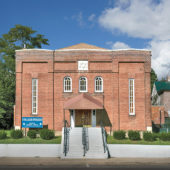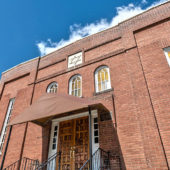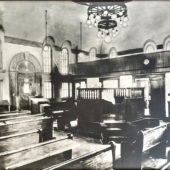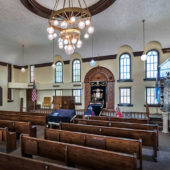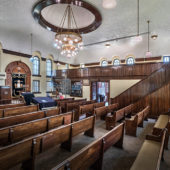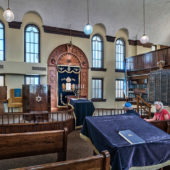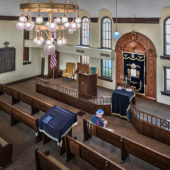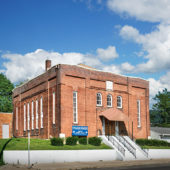One of Iowa’s few remaining small town synagogues.
At the beginning of the 20th century, Ottumwa had fewer than 50 Jewish families – primarily from Germany and Eastern Europe. Most were “in the junk and second–hand business”, but there were also laborers, shoemakers, tailors and one prominent merchant. They varied in their observance of Judaism – from orthodox to non–observant and unaffiliated. There was no organized community until 1898 when B’nai Jacob Congregation was established. In 1907, the congregation was located at 404 E. Main St. There were 15 member families out of an estimated Jewish population of 150. Hebrew school (15 pupils) met once a week.
Quoted from Wikipedia:
“B’nai Jacob’s Renaissance or Deco Vernacular synagogue building at 529 East Main Street (at Union Street) was constructed in 1915. The architects were L.T. Chrisman and company and George M. Kerns. The exterior is brick, with an addition in the back holding a kitchen and social hall, built sometime in the 1950s.
As originally built, the bimah was in the center of the sanctuary, but in an earlier modernization of the building, the central bimah was removed. The woodwork around the Torah ark is original, as is the 7–branched menorah in front of the ark. The ark doors and interior, however, are not original.
The sanctuary features a woman’s gallery against the south–west wall, built over the front entrance foyer and classroom, although it is rarely used. In traditional Judaism, women were seated separately from men, separated by a mechitza which frequently took the form of a balcony. The separation of men and women at B’nai Jacob ended when one woman’s health problems prevented her from climbing the stairs to the balcony.
The building was added to the National Register of Historic Places on August 10, 2004 (reference number 4000815), and underwent major historic restoration in 2004– 2005.”
By 1919 Ottumwa’s Jewish population had risen to 412. The Hebrew school had 1 teacher and 21 students and it had daily classes. The B’nai Jacob congregation had about 250 members during the 1930s and 1940s. In the 1950s, it affiliated with the Conservative movement. It is still Conservative today.
By 1951, the Jewish population of Ottumwa was 231. By 1960, it was 175. And by 1962, it was 150. For the next 2 decades, through 1983, the population remained unchanged. By 2010, there were only about the congregation on a typical Saturday morning was only 7. As of 2016, while there are about 10 members only 4 live in Ottumwa attending Saturday morning services on a consistent basis. Edna Ferber, famous author and Pulitzer Prize winning author of So Big, lived in Ottumwa in the 1890s for 7 years – age 5–12. Her family moved away due to harsh anti–Semitism. According to Wikipedia, Edna’s father operated The Fair, a department store in downtown Ottumwa. The ongoing anti–Semitism in Ottumwa had a lasting influence on Edna. She wrote of her years in Ottumwa: “I don’t think that there was a day when I wasn’t called a sheeny.”

